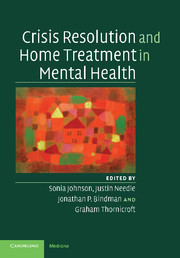Book contents
- Frontmatter
- Contents
- List of contributors
- Foreword
- Acknowledgements
- Section 1 Introduction and concepts
- Section 2 The evidence
- Section 3 Current practice
- 6 Crisis resolution teams: rationale and core model
- 7 The crisis resolution team within the community service system
- 8 Assessment of crises
- 9 Assessment and management of risk
- 10 Symptom management
- 11 Practical psychosocial interventions
- 12 Working with families and social networks
- 13 Strategies for promoting engagement and treatment adherence
- 14 Mixed blessings: service user experience of crisis teams
- 15 Early discharge and joint working between crisis teams and hospital services
- 16 Working with repeat users of crisis resolution services
- 17 Responding to diversity in home treatment
- 18 Coercion and compulsion in crisis resolution teams
- Section 4 Variations and enhancements
- Section 5 Developing a local service
- Index
15 - Early discharge and joint working between crisis teams and hospital services
from Section 3 - Current practice
Published online by Cambridge University Press: 13 August 2009
- Frontmatter
- Contents
- List of contributors
- Foreword
- Acknowledgements
- Section 1 Introduction and concepts
- Section 2 The evidence
- Section 3 Current practice
- 6 Crisis resolution teams: rationale and core model
- 7 The crisis resolution team within the community service system
- 8 Assessment of crises
- 9 Assessment and management of risk
- 10 Symptom management
- 11 Practical psychosocial interventions
- 12 Working with families and social networks
- 13 Strategies for promoting engagement and treatment adherence
- 14 Mixed blessings: service user experience of crisis teams
- 15 Early discharge and joint working between crisis teams and hospital services
- 16 Working with repeat users of crisis resolution services
- 17 Responding to diversity in home treatment
- 18 Coercion and compulsion in crisis resolution teams
- Section 4 Variations and enhancements
- Section 5 Developing a local service
- Index
Summary
In this chapter, we will examine some ways in which crisis resolution teams (CRTs) liaise and work with other acute care services, especially in facilitating early discharge from hospital. Ways of establishing strong and effective working relationships between hospital and crisis services will be described. Finally, different approaches to facilitating early discharge will be explored in three case studies.
The relationship between crisis and acute services
Much of the focus in the literature discussing CRTs tends to be on providing an alternative at the point of hospital admission. However, another important role, particularly where one of the main goals of introducing them is to reduce bed use and divert resources into community-based mental healthcare, is their potential for becoming involved following admission in order to allow early discharge from hospital. As yet, very little research has focused specifically on the effectiveness of strategies for reducing hospital stay.
Early discharge is perhaps the activity for which strong relationships between CRTs and ward teams are most important, but this relationship is also important when CRTs offer intensive home treatment to patients who present significant risks: rapid access to inpatient beds is needed if escalating risk and lack of treatment response make management at home unsustainable. An effective relationship with inpatient teams is important to allow CRTs to engage in positive risk taking with this group.
- Type
- Chapter
- Information
- Crisis Resolution and Home Treatment in Mental Health , pp. 187 - 196Publisher: Cambridge University PressPrint publication year: 2008



